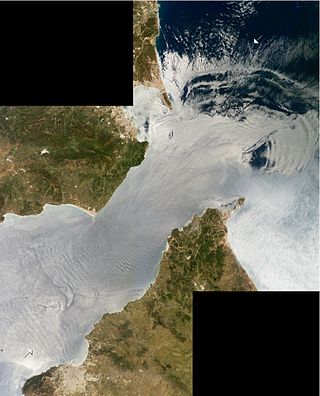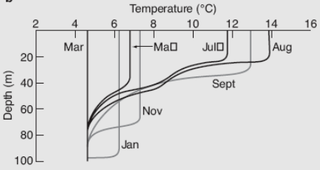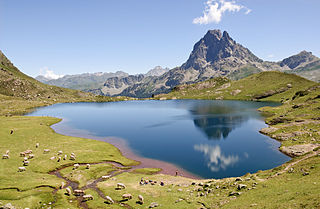External links
![]() The dictionary definition of caballing at Wiktionary
The dictionary definition of caballing at Wiktionary
A thermal bar is a hydrodynamic feature that forms around the edges of holomictic lakes during the seasonal transition to stratified conditions, due to the shorter amount of time required for shallow areas of the lake to stratify.
During the process of lake stratification, shallow areas generally become stratified before deeper areas. In large lakes this condition may persist for weeks, during which a temperature front known as a thermal bar forms between the stratified and unstratified areas of the lake. The thermal bar generally forms parallel to shore and moves toward the lake center as deeper areas of the lake stratify. While thermal bars can form in both fall and spring, most studies of the thermal bar have investigated aspects of the feature in the spring, when the lake is warming up and the summer thermocline is beginning to form.
At the lake surface, the thermal bar may be visible as a foam line between the stratified water shoreward of the thermal bar and unstratified water on the offshore side. At this convergence, waters mix and sink when they reach the temperature of maximum density, roughly 4 degrees Celsius for freshwater, a process known as cabbeling.
The downwelling of dense water at the thermal bar acts as a barrier to horizontal mixing. In spring, this concentrates warm water and suspended materials in the near shore waters around the edge of the lake. Satellite imagery has been used to identify thermal bars using their thermal characteristics as well as the concentration of suspended materials on their shoreward side, typically due to surface runoff to the lake.
Isotherms on the stratified side of the thermal bar slope away from the bar, producing a pressure gradient force that when balanced by the Coriolis force produces a cyclonic coastal geostrophic current that transports water and suspended matter along the shore.
The thermal bar phenomena was first described by François-Alphonse Forel in his study of Lac Leman. Additional studies have been carried out in Lake Ladoga, [1] Lake Baikal [2] and the Laurentian Great Lakes. [3]
Although a temporary seasonal feature, the thermal bar plays an important role in lake ecology by restricting mixing between coastal and offshore waters. This role is particularly evident during the spring runoff period when the retention of coastal waters may benefit aquatic organisms by providing warmer water temperatures and elevated nutrient concentrations, or may threaten coastal environments by retaining pollutants in coastal waters. [4]
![]() The dictionary definition of caballing at Wiktionary
The dictionary definition of caballing at Wiktionary

An estuary is a partially enclosed coastal body of brackish water with one or more rivers or streams flowing into it, and with a free connection to the open sea. Estuaries form a transition zone between river environments and maritime environments and are an example of an ecotone. Estuaries are subject both to marine influences such as tides, waves, and the influx of saline water, and to fluvial influences such as flows of freshwater and sediment. The mixing of seawater and freshwater provides high levels of nutrients both in the water column and in sediment, making estuaries among the most productive natural habitats in the world.

Limnology is the study of inland aquatic ecosystems. The study of limnology includes aspects of the biological, chemical, physical, and geological characteristics of fresh and saline, natural and man-made bodies of water. This includes the study of lakes, reservoirs, ponds, rivers, springs, streams, wetlands, and groundwater. Water systems are often categorized as either running (lotic) or standing (lentic).

The epilimnion or surface layer is the top-most layer in a thermally stratified lake.

A thermocline is a distinct layer based on temperature within a large body of fluid with a high gradient of distinct temperature differences associated with depth. In the ocean, the thermocline divides the upper mixed layer from the calm deep water below.

Internal waves are gravity waves that oscillate within a fluid medium, rather than on its surface. To exist, the fluid must be stratified: the density must change with depth/height due to changes, for example, in temperature and/or salinity. If the density changes over a small vertical distance, the waves propagate horizontally like surface waves, but do so at slower speeds as determined by the density difference of the fluid below and above the interface. If the density changes continuously, the waves can propagate vertically as well as horizontally through the fluid.

The spring bloom is a strong increase in phytoplankton abundance that typically occurs in the early spring and lasts until late spring or early summer. This seasonal event is characteristic of temperate North Atlantic, sub-polar, and coastal waters. Phytoplankton blooms occur when growth exceeds losses, however there is no universally accepted definition of the magnitude of change or the threshold of abundance that constitutes a bloom. The magnitude, spatial extent and duration of a bloom depends on a variety of abiotic and biotic factors. Abiotic factors include light availability, nutrients, temperature, and physical processes that influence light availability, and biotic factors include grazing, viral lysis, and phytoplankton physiology. The factors that lead to bloom initiation are still actively debated.

Thermal pollution, sometimes called "thermal enrichment", is the degradation of water quality by any process that changes ambient water temperature. Thermal pollution is the rise or fall in the temperature of a natural body of water caused by human influence. Thermal pollution, unlike chemical pollution, results in a change in the physical properties of water. A common cause of thermal pollution is the use of water as a coolant by power plants and industrial manufacturers. Urban runoff—stormwater discharged to surface waters from rooftops, roads and parking lots—and reservoirs can also be a source of thermal pollution. Thermal pollution can also be caused by the release of very cold water from the base of reservoirs into warmer rivers.

A pycnocline is the cline or layer where the density gradient is greatest within a body of water. An ocean current is generated by the forces such as breaking waves, temperature and salinity differences, wind, Coriolis effect, and tides caused by the gravitational pull of celestial bodies. In addition, the physical properties in a pycnocline driven by density gradients also affect the flows and vertical profiles in the ocean. These changes can be connected to the transport of heat, salt, and nutrients through the ocean, and the pycnocline diffusion controls upwelling.

Lake stratification is the tendency of lakes to form separate and distinct thermal layers during warm weather. Typically stratified lakes show three distinct layers: the epilimnion, comprising the top warm layer; the thermocline, the middle layer, whose depth may change throughout the day; and the colder hypolimnion, extending to the floor of the lake.

The Alaska Current is a southwestern shallow warm-water current alongside the west coast of the North American continent beginning at about 48-50°N. The Alaska Current produces large clockwise eddies at two sites: west of the Haida Gwaii and west of Sitka, Alaska.

A lake ecosystem or lacustrine ecosystem includes biotic (living) plants, animals and micro-organisms, as well as abiotic (non-living) physical and chemical interactions. Lake ecosystems are a prime example of lentic ecosystems, which include ponds, lakes and wetlands, and much of this article applies to lentic ecosystems in general. Lentic ecosystems can be compared with lotic ecosystems, which involve flowing terrestrial waters such as rivers and streams. Together, these two ecosystems are examples of freshwater ecosystems.

The oceanic or limnological mixed layer is a layer in which active turbulence has homogenized some range of depths. The surface mixed layer is a layer where this turbulence is generated by winds, surface heat fluxes, or processes such as evaporation or sea ice formation which result in an increase in salinity. The atmospheric mixed layer is a zone having nearly constant potential temperature and specific humidity with height. The depth of the atmospheric mixed layer is known as the mixing height. Turbulence typically plays a role in the formation of fluid mixed layers.
A dimictic lake is a body of freshwater whose difference in temperature between surface and bottom layers becomes negligible twice per year, allowing all strata of the lake's water to circulate vertically. All dimictic lakes are also considered holomictic, a category which includes all lakes which mix one or more times per year. During winter, dimictic lakes are covered by a layer of ice, creating a cold layer at the surface, a slightly warmer layer beneath the ice, and a still-warmer unfrozen bottom layer, while during summer, the same temperature-derived density differences separate the warm surface waters, from the colder bottom waters. In the spring and fall, these temperature differences briefly disappear, and the body of water overturns and circulates from top to bottom. Such lakes are common in mid-latitude regions with temperate climates.
Monomictic lakes are holomictic lakes that mix from top to bottom during one mixing period each year. Monomictic lakes may be subdivided into cold and warm types.
Amictic lakes are "perennially sealed off by ice, from most of the annual seasonal variations in temperature." Amictic lakes exhibit inverse cold water stratification whereby water temperature increases with depth below the ice surface 0 °C (less-dense) up to a theoretical maximum of 4 °C.

A lake is a naturally occurring, relatively large body of water localized in a basin surrounded by dry land. A lake generally has a slower-moving flow than the inflow or outflow stream(s) that serve to feed or drain it. Lakes lie completely on land and are separate from the ocean, although, like the much larger oceans, they form part of the Earth's water cycle by serving as large standing pools of storage water. Most lakes are freshwater and account for almost all the world's surface freshwater, but some are salt lakes with salinities even higher than that of seawater.

Freshwater biology is the scientific biological study of freshwater ecosystems and is a branch of limnology. This field seeks to understand the relationships between living organisms in their physical environment. These physical environments may include rivers, lakes, streams, ponds, lakes, reservoirs, or wetlands. Knowledge from this discipline is also widely used in industrial processes to make use of biological processes involved with sewage treatment and water purification. Water presence and flow is an essential aspect to species distribution and influences when and where species interact in freshwater environments.
Estuarine water circulation is controlled by the inflow of rivers, the tides, rainfall and evaporation, the wind, and other oceanic events such as an upwelling, an eddy, and storms. Estuarine water circulation patterns are influenced by vertical mixing and stratification, and can affect residence time and exposure time.

Stratification in water is the formation in a body of water of relatively distinct and stable layers by density. It occurs in all water bodies where there is stable density variation with depth. Stratification is a barrier to the vertical mixing of water, which affects the exchange of heat, carbon, oxygen and nutrients. Wind-driven upwelling and downwelling of open water can induce mixing of different layers through the stratification, and force the rise of denser cold, nutrient-rich, or saline water and the sinking of lighter warm or fresher water, respectively. Layers are based on water density: denser water remains below less dense water in stable stratification in the absence of forced mixing.
Stable stratification of fluids occurs when each layer is less dense than the one below it. Unstable stratification is when each layer is denser than the one below it.